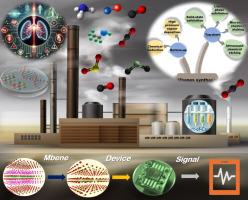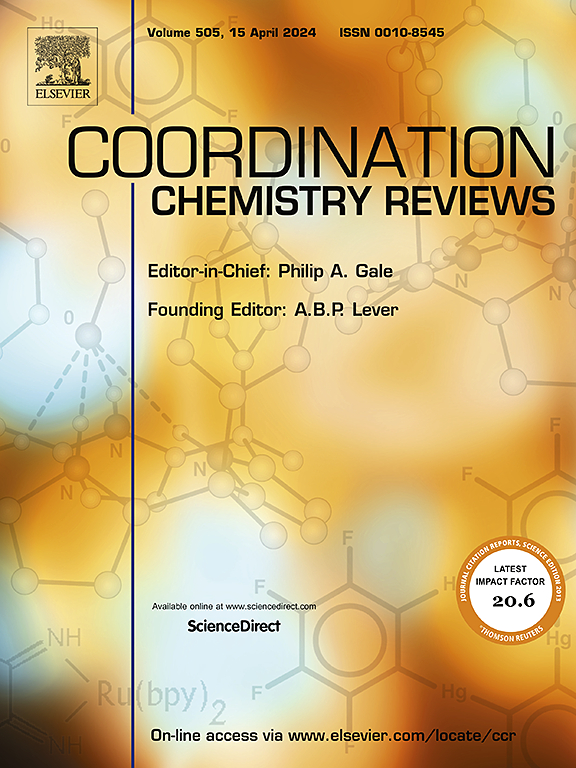Unlocking the potential of MBenes for sensing applications: A review of gas and biosensor innovations
IF 20.3
1区 化学
Q1 CHEMISTRY, INORGANIC & NUCLEAR
引用次数: 0
Abstract
Sensors have emerged as crucial tools in various fields, particularly in environmental monitoring and healthcare diagnostics, driven by increasing global health and environmental concerns. Among the promising materials, metal borides, or MBenes, have gained attention for their tunable electronic properties, large surface area, and chemical stability. MBenes demonstrate exceptional potential in both gas and biosensing applications due to their high conductivity and surface reactivity, making them adept at detecting low concentrations of hazardous gases and selectively interacting with biomolecules. This review discusses recent advances in the synthesis, structural modifications, and functionalization of MBenes, emphasizing their role in enhancing sensor selectivity and sensitivity. It also explores theoretical and experimental insights into their interactions with target analytes while outlining the challenges and opportunities for their integration into practical sensing systems. Key achievements include the development of MBene-based gas sensors capable of detecting ultra-low concentrations of gases such as NO2, NO, CO, CO2, NH3, SO, SO2, humidity and various fluorocarbons (e.g., C4F7N, C5F10O, CF4, C3F6, COF2) with unprecedented sensitivity and fast response times. Additionally, MBene-based biosensors have demonstrated remarkable performance in detecting biomolecules and pathogens, offering significant improvements in detection limits and specificity compared to traditional sensing platforms. This review concludes by outlining future research directions aimed at further enhancing MBene-based sensor performance, exploring new applications, and integrating these materials into practical sensing technologies for environmental monitoring, healthcare diagnostics, and industrial process control.


释放MBenes在传感应用中的潜力:气体和生物传感器创新综述
在日益增加的全球健康和环境问题的推动下,传感器已成为各个领域的关键工具,特别是在环境监测和医疗保健诊断方面。在有前途的材料中,金属硼化物(MBenes)因其可调谐的电子特性、大表面积和化学稳定性而受到关注。由于其高导电性和表面反应性,MBenes在气体和生物传感应用中表现出非凡的潜力,使其擅长检测低浓度的有害气体并选择性地与生物分子相互作用。本文综述了MBenes的合成、结构修饰和功能化的最新进展,强调了它们在提高传感器选择性和灵敏度方面的作用。它还探讨了与目标分析物相互作用的理论和实验见解,同时概述了将其整合到实际传感系统中的挑战和机遇。主要成果包括开发基于mbene的气体传感器,能够检测超低浓度的气体,如NO2, NO, CO, CO2, NH3, SO, SO2,湿度和各种氟碳化合物(如C4F7N, c5f100, CF4, C3F6, COF2),具有前所未有的灵敏度和快速响应时间。此外,基于mbene的生物传感器在检测生物分子和病原体方面表现出了显著的性能,与传统的传感平台相比,在检测限和特异性方面有了显著的提高。本文最后概述了未来的研究方向,旨在进一步提高基于mbene的传感器性能,探索新的应用,并将这些材料集成到环境监测、医疗诊断和工业过程控制的实际传感技术中。
本文章由计算机程序翻译,如有差异,请以英文原文为准。
求助全文
约1分钟内获得全文
求助全文
来源期刊

Coordination Chemistry Reviews
化学-无机化学与核化学
CiteScore
34.30
自引率
5.30%
发文量
457
审稿时长
54 days
期刊介绍:
Coordination Chemistry Reviews offers rapid publication of review articles on current and significant topics in coordination chemistry, encompassing organometallic, supramolecular, theoretical, and bioinorganic chemistry. It also covers catalysis, materials chemistry, and metal-organic frameworks from a coordination chemistry perspective. Reviews summarize recent developments or discuss specific techniques, welcoming contributions from both established and emerging researchers.
The journal releases special issues on timely subjects, including those featuring contributions from specific regions or conferences. Occasional full-length book articles are also featured. Additionally, special volumes cover annual reviews of main group chemistry, transition metal group chemistry, and organometallic chemistry. These comprehensive reviews are vital resources for those engaged in coordination chemistry, further establishing Coordination Chemistry Reviews as a hub for insightful surveys in inorganic and physical inorganic chemistry.
 求助内容:
求助内容: 应助结果提醒方式:
应助结果提醒方式:


